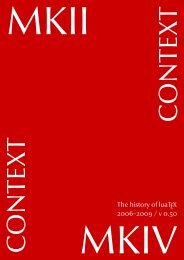ConTEXt an excursion - Pragma ADE
ConTEXt an excursion - Pragma ADE
ConTEXt an excursion - Pragma ADE
You also want an ePaper? Increase the reach of your titles
YUMPU automatically turns print PDFs into web optimized ePapers that Google loves.
Tables<br />
For placing a table the comm<strong>an</strong>d \placetable is used which is a predefined example of:<br />
contents<br />
\placeblock[.1.][ref,..]{.2.}{.3.}<br />
For defining the table you use:<br />
\starttable[...] ... \stoptable<br />
index<br />
comm<strong>an</strong>ds<br />
definitions<br />
colofon<br />
The definition of a table could look something like this:<br />
\placetable[here][tab:ships]{Ships that moored at Hasselt.}<br />
\starttable[|c|c|]<br />
\HL<br />
\NC \bf Year \NC \bf Number of ships \NC\SR<br />
\HL<br />
\NC 1645 \NC 450 \NC\FR<br />
\NC 1671 \NC 480 \NC\MR<br />
\NC 1676 \NC 500 \NC\MR<br />
\NC 1695 \NC 930 \NC\LR<br />
\HL<br />
\stoptable<br />
This table is typeset as table 11.1.<br />
The first comm<strong>an</strong>d \placetable has the same function as \placefigure. It takes care<br />
of spacing before <strong>an</strong>d after the table <strong>an</strong>d numbering. Furthermore the floating mech<strong>an</strong>ism<br />
is initialized so the table will be placed at the most optimal location of the page.<br />
exit<br />
search +<br />
3<br />
CONT E XT was developed for non--technical users in the WYSIWYG era. Therefore a user friendly interface <strong>an</strong>d easy<br />
file <strong>an</strong>d comm<strong>an</strong>d h<strong>an</strong>dling were needed, <strong>an</strong>d cryptic comm<strong>an</strong>ds, programming <strong>an</strong>d logical reasoning had to<br />
be avoided.<br />
go back<br />
– +<br />
11 33
















